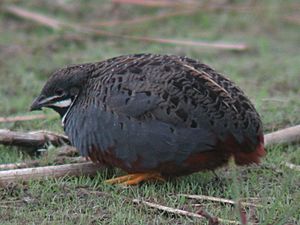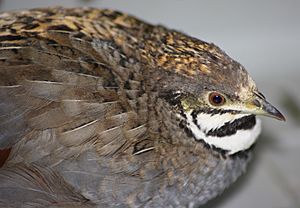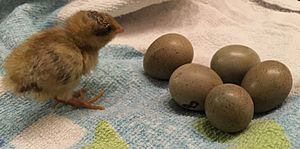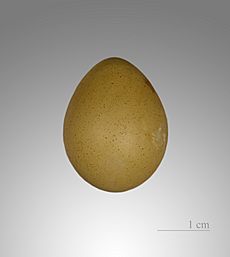King quail facts for kids
Quick facts for kids King quail |
|
|---|---|
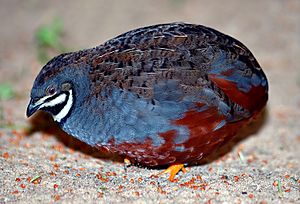 |
|
| Conservation status | |
| Scientific classification | |
| Genus: |
Excalfactoria
|
| Species: |
chinensis
|
| Synonyms | |
|
|
The king quail (Excalfactoria chinensis) is a tiny bird that belongs to the quail family. It's also known by other names like the blue-breasted quail or Chinese painted quail. This bird is the smallest "true quail" in the world!
King quails live in the wild across southeastern Asia and Oceania. There are about 10 different kinds, or subspecies, of this bird. People tried to bring them to New Zealand a long time ago, but it didn't work out. These quails are very popular as pets around the world. Sometimes, people mistakenly call them "button quails," but button quails are actually a different type of bird.
Contents
About the King Quail
Male king quails can have many different colors. Their feathers might be blue, brown, silver, maroon, dark brown, or almost black. They have bright orange feet that are strong and tough. This helps them live on the ground, just like many other game birds. Female king quails look similar to males, but they don't come in blue colors.
In captivity, king quails can live for up to 13 years. However, they usually live for about 3 to 6 years. In the wild, their lives are much shorter, often only around 1.5 years. King quail eggs are a light, creamy-brown color. They are slightly pointed at one end and are shaped like an oval.
Where King Quails Live
There are several different types of king quails, depending on where they live. Here are a few examples:
- The E. c. chinensis type is found in places like India, Sri Lanka, China, and Taiwan.
- The Nicobar blue-breasted quail lives on the Andaman and Nicobar Islands.
- Another type, E. c. lineata, is found in the Philippines, Borneo, and other islands.
- The E. c. australis type lives in eastern Australia.
- The E. c. colletti type is found in northern Australia.
King Quail Reproduction
Male king quails will often fight to decide who gets to mate with the females. The winning male will then breed with all the females. After mating, a female can lay an egg within one or two days.
Female quails might build a nest, or they might just lay their eggs on the ground. They usually start sitting on their eggs (this is called being "broody") when they have laid enough eggs. A group of eggs laid at one time is called a "clutch." A clutch can have anywhere from 5 to 13 eggs. In captivity, it's best for a clutch to have 6 to 8 eggs. All the eggs in a clutch are laid before the mother starts to incubate them. The baby chicks hatch after about 16 days.
King Quails as Pets
King quails have been very popular pets for many years. People have even bred them to have many different colors and patterns. These birds are quite tough once they get used to their new home. They are great at keeping the bottom of an aviary (a large bird cage) clean. A big plus is that they stay on the ground and won't bother other birds in the aviary. They are also not very expensive to buy or take care of. Some king quails can even become tame enough to be held!
You can keep these quails in pairs, small groups, or even in larger colonies in big outdoor enclosures. Males might sometimes fight, and females can too. It's important to have a good place for them to live.
If female quails are fed the right diet, they can lay an egg every day. For nesting, they like a quiet corner or a small dip in the ground near a wall. It's good to give them some long grass, branches, or a pile of loose plants to hide in. Sometimes, a female will lay eggs on the aviary floor without a nest. This might mean she's not happy with her nesting options, so adding a sheltered spot could help. The male usually picks the nest spot. The nest is a simple scrape in the ground, lined with grasses, and built by the female with some help from the male.
The eggs are about 25 x 19mm in size. Their color can vary from very pale brown to dark olive, often with tiny black spots. A clutch usually has 4 to 13 eggs. Sometimes, a female might be found sitting on more than 20 eggs! This usually happens when several females lay their eggs in the same nest. It can be hard for the mother to turn and cover so many eggs, so not all of them might hatch. It's often better to take some eggs out and hatch them artificially or let another bird care for them.
King quails usually breed all year round. The eggs hatch after about 18 to 23 days. The mother bird will take care of the chicks until they are about 4 weeks old. At that point, they should be moved to a separate aviary away from their parents.
King Quail Colors
People have bred king quails to have many different colors and patterns. Silver and cinnamon colors are very common. Other patterns like pied (patches of color) and charcoal are also becoming more popular. Sometimes, you can even find albino quails, which are completely white. These different colors can be mixed to create even more unique birds!
What King Quails Eat
In the wild, king quails eat small insects, seeds, and different types of grasses that they find. When kept as pets, they should be fed a mix of seeds, along with healthy fruits and vegetables. When females are laying eggs, they need food rich in calcium, like crushed oyster shells. This helps prevent problems with egg laying. Baby chicks should be fed a high-protein chick crumb mixed with a little water. Other good sources of protein for them include mealworms and various small bugs.
|
See also
 In Spanish: Codorniz china para niños
In Spanish: Codorniz china para niños



